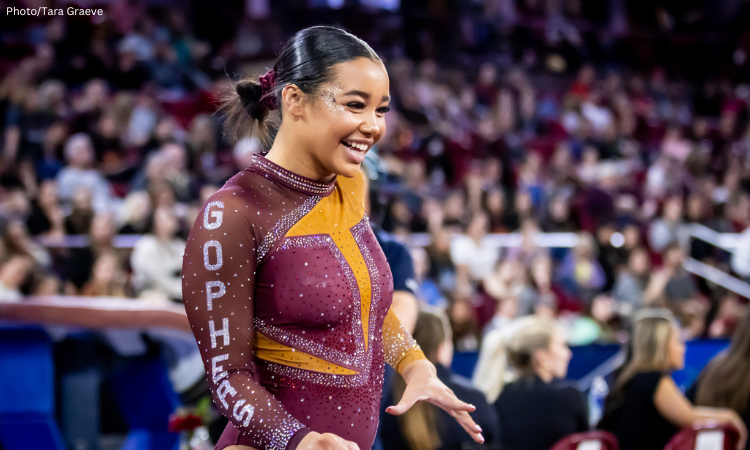If you’ve ever watched college gymnastics, you might have seen this before: your mom, eyebrows furrowed, head shaking, and mouth agape, claiming she can design a better leotard than some coaching staff. Whether you’re the most seasoned college gymnastics fan, or a total newbie, everyone has opinions about leotard designs. While it’s easy to scrutinize leotards, few people know about the time, effort, and money that goes into the design process. You’re about to get a behind-the-scenes look at what it takes to create leotards for top college gymnastics teams, thanks to insights from the coaches themselves.
For many coaches, the first step in designing a leotard is finding inspiration: A specific color palette? Nature? Maybe even another collegiate team? Geralen Stack-Eaton, assistant coach of the Minnesota Gophers and former Alabama gymnast starts with social media. “I’ll go on Instagram and Pinterest and look for figure skating outfits, ballroom dancing, prom dresses with cool backs and designs and that’s mainly where I start just to get inspiration,” said Stack-Eaton.
Erin Dooley, assistant coach for Maryland and former Florida gymnast, always has her eyes peeled for the latest design trends across the NCAA scene. “First I try to see what’s the most popular thing going on. Is it the high neck? The bling? The rhinestones? The really cool backs? So I try to use that to decide on the theme,” said Dooley.
Although Dooley takes inspiration from other teams’ design trends, she notes that each team adds its personal flair like Oklahoma’s rhinestone designs on the front. “I always go through catalogs to see what designs can be picked there, and then put my own twist on it,” said Dooley.
Another important aspect of the design process is ensuring the athletes are included in the conversations. Dooley gets lots of input from the athletes about what they are and aren’t comfortable wearing so they feel confident and empowered in their uniforms. “I listen to the girls because they’re the ones wearing the leotard, and I want them to feel so empowered and amazing wearing it,” Dooley said.
Coaches also need to work alongside leotard companies to ensure their ideas are feasible. Stack-Eaton works closely with GK to test idea the viability of each design she sketches from both a design and a cost viewpoint. “I show my GK representative my ideas and about where I’m going,” she said, “and then they take those designs, and they do graphic mockups.”
Working with the leotard company is a collaborative process as coach and representative try to hone in on the best version of the leotard through experimentation. “Sometimes it’s hard to explain what you want, and then when you see it working together you find yourself saying ‘OK this doesn’t quite work, can we try this color? This fabric?’”, said Stack-Eaton. “So it’s nice that we get to see and feel the different swatches. It’s a very collaborative and inspirational collective that we have.”
Once a leotard goes from idea to reality, coaches don’t always know how gymnasts and fans will react to the design. Stack-Eaton decided to test the waters with a new Ozone leotard the team wore at Denver regionals during the 2023 season where it was met with controversy for the skin-tone match of its mesh.
The idea behind the leotard came from ballroom dancing. Stack-Eaton wanted the leotard to incorporate the asymmetrical patterns and nude-colored mesh she saw in ballroom dance costumes. While it’s one of her favorites, she recognizes not everyone is a fan.
“I know it’s not a favorite on the internet, but again you try things and you like it and other people don’t,” said Stack-Eaton. “But you know you got to be able to push the envelope, and there’s always going to be some negative feedback but there’s also going to be positive feedback.” The leotard may have gotten mixed reviews, but the team liked the design and decided to wear it again. This season, the team debuted a new iteration that better matched gymnasts’ skin tones, bringing the leotard closer to Stack-Eaton’s vision.
Another leotard that turned heads this season was UCLA’s Empower Pride leotard, which took inspiration from stained-glass windows to create a mosaic pride flag. When designing the leotard, head coach Janelle McDonald wanted to find ways to draw upon inspiration from architecture, UCLA school colors, and of course the colors of the pride flag.
“In designing this year’s Empower Pride leotard, I did make decisions to stay closer to school colors, said McDonald. “The idea was to have the vibrant colors of the Pride flag be used in a mosaic, or more specifically a stained-glass window look.”
McDonald also experimented with the base color of the leotard, initially considering a black base to make the other colors pop. However, she ultimately decided to make the base blue to stay closer to UCLA’s school colors.
When it comes down to the final design, no matter how controversial a leotard’s color palette, sleeves (or lack thereof), fabric choices, or Swarovski crystal designs, the most important thing is that the athlete wearing the leotard feels safe, comfortable, and confident wearing it.
In Erin Dooley’s Florida days, wearing a great leotard acted like a psychological power-up to go out and do great gymnastics. “It really just gave me that little extra boost of empowerment and confidence,” said Dooley. “You can just go out there and feel free and confident.”
READ THIS NEXT: Leotard Rankings: Conference Championships
Article by Daniel Rothwell





12 comments